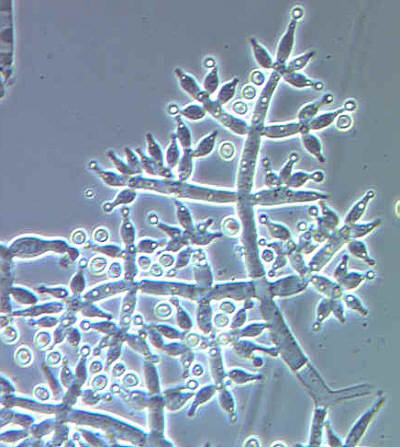COMPOSITION, PROPERTIES AND RECYCLING OF VEGETATIVE POPLAR AFTER REMOVAL OF EXTRAC-TIVES. REPORT 3. OBTAINING BIOIOGICAL PRODUCTS BASED ON FUNGI OF THE GENUS TRIGHODERMA
UDC 630.86 + 674.031.623.237.7:630.86
Abstract
The purpose of this work was to assess the suitability of solid and liquid waste generated during processing of the vegetative part of poplar as substrates for biochemical processing in order to obtain biologics for various purposes. For the study, we used post-extraction residues, as well as a cubic liquid formed after distilling essential oils and extracting alcohol-soluble substances from the vegetative part of the balsamic poplar (Populus balzamifera L.). Siberian strains of fungi of the genus Trichoderma used as a biodestructor.
Studies have shown that the vegetative part of poplar and its individual elements are an available substrate for the growth of mycelial fungi. The high yield of spores (4.5×109 spor/g) and the formation of humic substances (11%) used as plant growth stimulators during solid-phase cultivation of the MG-97 strain of Trichoderma fungi gives grounds to use the vegetative part of poplar as a technological raw material for obtaining a biological product of the "Trichodermin" type or soil humification. Depending on the purpose of the preparations, the duration of cultivation can vary: for obtaining agricultural biologics up to 15 days, more – for soil humification. The inclusion of a cubic liquid at the stage of substrate humidification allows to obtain a biological product with a higher spore titer (5×109 spor/g), makes it possible to close the water consumption cycle and make the technology of processing the vegetative part of poplar waste-free.
Downloads
Metrics
References
Ripachek V.I. Biologiya derevorazrushayushchikh gribov. [Biology of wood-destroying fungi]. Moscow, 1967, 276 p. (in Russ.).
Skryabin G.K. Mikologiya i fitopatologiya, 1986, no. 5, pp. 976–983. (in Russ.).
Makhova Ye.G., Ryazanova T.V., Chuprova N.A. Khimiya rastitel'nogo syr'ya, 2001, no. 4, pp. 69–72. (in Russ.).
Bilay V.I., Bilay T.I., Musich Ye.G. Transformatsiya tsellyulozy gribami. [Transformation of cellulose by fungi]. Kiev, 1982, 296 p. (in Russ.).
Svistova I.D., Bab'yeva Ye.N. Mikologiya i fitopatologiya. 1986, vol. 20, no. 2, pp. 120–123. (in Russ.).
Sadykova V.S., Rogozhin E.A., Kurakov A.V., Kuvarina A.E. Applied Biochemistry and Microbiology, 2015, vol. 51, no. 3, pp. 355–361.
Skvortsov Ye.V., Alimova F.K., Abuzyarova D.M. Vestnik kazanskogo tekhnologicheskogo universiteta, 2005, no. 1, pp. 251–255. (in Russ.).
Soriente I., Ferraioli S., Woo S. at. al. 9th International Workshop on Trichoderma and Gliocladium, Vienna, Austria, 2006.
Kurakov A.V., Khidirov K.S., Zvyagintsev D.G., Sadykova V.S. Applied Biochemistry and Microbiology, 2011, vol. 47, no. 2, pp. 169–175.
Gavrilov S.V., Kanarskiy A.V., Skvortsov Ye.V., Sevast'yanova Yu.V. Lesnoy zhurnal, 2016, no. 6, pp. 142–152. (in Russ.).
Alimova F.K. Promyshlennoye primeneniye gribov roda Trichoderma. [Industrial use of fungi of the genus Trichoder-ma]. Kazan', 2006, 209 p. (in Russ.).
Manukovskiy N.S. Kinetika biokonversii lignotsellyuloz. [Kinetics of lignocellulose bioconversion]. Novosibirsk, 1990. 26 p. (in Russ.).
Tashpulatov Zh.S., Baybayev B.I. Uzbekskiy biologicheskiy zhurnal, 1990, no. 4, pp. 10–12. (in Russ.).
Agosin E. Aguilera J.M. Trichoderma and Gliocladium. Vol. 2. Enzymes, biological control and commercial applica-tion. London: Taylor and Francis Ltd., 1998, pp. 205–227.
Tillayev Kh.T., Velitskaya I.S. Mikologiya i fitopatologiya, 1981, vol. 15, no. 4, pp. 317–321. (in Russ.).
Fedorinchik N.S. Sel'sko-khozyaystvennaya biologiya, 1977, vol. 12, no. 1, pp. 69–73. (in Russ.).
Gromovykh T.I., Litovka Yu.A., Gromovykh B.C., Makhova Ye.G. Mikologiya i fitopatologiya, 2002, vol. 36, no. 4, pp. 70–75. (in Russ.).
Sadycova V.S., Gromovykh T.I., Likhachev F.N., Kurakov A.V., Ushanova V.M. Biotechnology in Russia, 2007, no. 6, pp. 10–18.
Litovka Yu.A., Gromovykh T.I., Gukasyan V.M. Sibirskiy ekologicheskiy zhurnal, 2002, no. 3, pp. 371–376. (in Russ.).
Lunova T.A., Kim N.Yu., Ryazanova T.V., Chuprova N.A. Izvestiya vuzov. Khimiya i khimicheskaya tekhnologiya, 2006, vol. 49, no. 6, pp. 88–91. (in Russ.).
Ryazanova T.V., Chuprova N.A., Litovka Yu.A. Sistemy. Metody. Tekhnologii, 2016, no. 1 (29), pp. 147–151. (in Russ.).
Gaydasheva I.I., Sadykova V.S., Bondar' P.N., Zobova N.V., Gromovykh T.I. Vestnik KrasGAU, 2008, no. 1, pp. 74–78. (in Russ.).
Isayeva Ye.V., Ryazanov T.V. Khimiya rastitel'nogo syr'ya, 2012, no. 3, pp. 59–65. (in Russ.).
Isayev Ye.V, Lozhkina G.A., Ryazanova T.V. Vestnik KrasGAU, 2006, no. 15, pp. 219–222. (in Russ.).
Isayeva Ye.V., Mamayeva O.O., Ryazanova T.V. Zhurnal Sibirskogo federal'nogo universiteta. Khimiya, 2017, no. 3, pp. 382–389. (in Russ.).
Lozhkina G.A., Isaeva E.V., Ryazanova T.V. Russian Journal of Bioorganic Chemistry, 2010, vol. 36, no. 7, pp. 1–5.
Isayeva Ye.V., Lozhkina G.A., Litovka Yu.A., Ryazanova T.V. Khimiya rastitel'nogo syr'ya, 2008, no. 1, pp. 67–72. (in Russ.).
Ryazanova T.V., Chuprova N.A., Isayeva Ye.V. Khimiya drevesiny. [Wood chemistry]. Saarbrucken, 2012, 428 p. (in Russ.).
Keyts M. Tekhnika lipidologii. [Technique of lipidology]. Moscow, 1975, 322 p. (in Russ.).
Isayeva Ye.V. Kompleksnaya pererabotka vegetativnoy chasti topolya bal'zamicheskogo s polucheniyem biologiche-ski aktivnykh produktov: avtoref. diss. … d-ra tekhn. nauk. [omplex processing of the vegetative part of the balsam poplar to obtain biologically active products: abstract diss. … Dr. Tech. sciences]. Krasnoyarsk, 2008, 43 p. (in Russ.).
Makhova Ye.G. Kul'tivirovaniye gribov roda na uglevodnykh substratakh i polucheniye biopreparata: avtoref. diss. … kand. tekhn. nauk. [ultivation of fungi of the genus on carbohydrate substrates and obtaining a biological product: au-thor. diss. ... Cand. tech. sciences]. Krasnoyarsk, 2003, 22 p. (in Russ.).
Tankanen T.M. Characterization of esterases acting on hemicelluloses: Ph.D. Thes., techn.res. Centre of Finland. Hel-sinki, 1997. 94 p.

Copyright (c) 2020 chemistry of plant raw material

This work is licensed under a Creative Commons Attribution 4.0 International License.

This work is licensed under a Creative Commons Attribution 4.0 International License.
The authors, which are published in this journal, agree to the following conditions:
1. Authors retain the copyright to the work and transfer to the journal the right of the first publication along with the work, at the same time licensing it under the terms of the Creative Commons Attribution License, which allows others to distribute this work with the obligatory indication of the authorship of this work and a link to the original publication in this journal .
2. The authors retain the right to enter into separate, additional contractual agreements for the non-exclusive distribution of the version of the work published by this journal (for example, to place it in the university depository or to publish it in a book), with reference to the original publication in this journal.
3. Authors are allowed to post their work on the Internet (for example, in a university repository or on their personal website) before and during the review process of this journal, as this may lead to a productive discussion, as well as more links to this published work.











